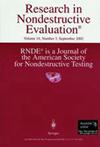Mechanical Sensing Properties of Embedded Smart Piezoelectric Sensor for Structural Health Monitoring of Concrete
IF 1
4区 材料科学
Q3 MATERIALS SCIENCE, CHARACTERIZATION & TESTING
引用次数: 9
Abstract
ABSTRACT An embedded smart piezoelectric sensor was fabricated, and the encapsulation material was prepared with cement, epoxy resin, curing agent, and improvement additives. Structural health monitoring (SHM) methods based on dynamic stress-sensing capability of piezoelectric sensor were presented. Mechanical Testing & Simulation (MTS) amplitude-scanning and frequency-scanning dynamic loadings were designed. Mechanical performance of encapsulation material, i.e., strength, Young modulus, and stress transmitting loss; the effects of different loading frequencies on output voltages; and stress sensitivities (V/MPa), were investigated. The electromechanical impedance and mechanical responses of embedded sensors with various loadings were studied in concrete. Theoretical formula indicates that output voltage is mainly related with external stress and area of Piezoelectric Lead Zirconate Titanate (PZT) ceramic. The optimized ratio of 4:2:0.5:1.6–4:2:0.5:2 is satisfactory and it can ensure optimal mechanical performance of encapsulation material. Stress sensitivities increase with the areas of PZT ceramic, and the effects of thickness on sensitivities are not obvious. The impedance response curve has left shifting tendency with the increase of dynamic cycles and loading values. The three-point bending destruction during concrete static loading can be in real-time reflected. The embedded sensors were suitable for dynamic mechanical monitoring in concrete. The excellent mechanical sensing performance exhibits great application potentials for SHM of concrete in civil engineering.嵌入式智能压电传感器在混凝土结构健康监测中的力学传感特性研究
采用水泥、环氧树脂、固化剂和改性添加剂制备了嵌入式智能压电传感器封装材料。提出了基于压电传感器动态应力感知能力的结构健康监测方法。设计了扫描幅值和扫描频率动态载荷的机械测试与仿真(MTS)。包封材料的力学性能,即强度、杨氏模量、传应力损失;不同负载频率对输出电压的影响;以及应力敏感性(V/MPa)。研究了混凝土中嵌入式传感器在不同载荷作用下的机电阻抗和力学响应。理论公式表明,输出电压主要与压电锆钛酸铅(PZT)陶瓷的外部应力和面积有关。最佳配比为4:2:0.5:1.6-4:2:0.5:2,可保证包封材料的最佳力学性能。应力敏感性随PZT陶瓷面积的增加而增加,厚度对灵敏度的影响不明显。阻抗响应曲线随动周数和加载值的增加呈移移趋势。可实时反映混凝土静载过程中的三点弯曲破坏。嵌入式传感器适用于混凝土的动态力学监测。优异的力学传感性能显示了混凝土SHM在土木工程中的巨大应用潜力。
本文章由计算机程序翻译,如有差异,请以英文原文为准。
求助全文
约1分钟内获得全文
求助全文
来源期刊

Research in Nondestructive Evaluation
工程技术-材料科学:表征与测试
CiteScore
2.30
自引率
0.00%
发文量
14
审稿时长
>12 weeks
期刊介绍:
Research in Nondestructive Evaluation® is the archival research journal of the American Society for Nondestructive Testing, Inc. RNDE® contains the results of original research in all areas of nondestructive evaluation (NDE). The journal covers experimental and theoretical investigations dealing with the scientific and engineering bases of NDE, its measurement and methodology, and a wide range of applications to materials and structures that relate to the entire life cycle, from manufacture to use and retirement.
Illustrative topics include advances in the underlying science of acoustic, thermal, electrical, magnetic, optical and ionizing radiation techniques and their applications to NDE problems. These problems include the nondestructive characterization of a wide variety of material properties and their degradation in service, nonintrusive sensors for monitoring manufacturing and materials processes, new techniques and combinations of techniques for detecting and characterizing hidden discontinuities and distributed damage in materials, standardization concepts and quantitative approaches for advanced NDE techniques, and long-term continuous monitoring of structures and assemblies. Of particular interest is research which elucidates how to evaluate the effects of imperfect material condition, as quantified by nondestructive measurement, on the functional performance.
 求助内容:
求助内容: 应助结果提醒方式:
应助结果提醒方式:


